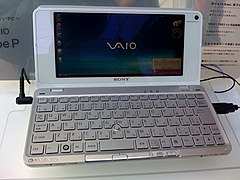VAIO
From Wikipedia, the free encyclopedia
| | The neutrality of this article is disputed. Please see the discussion on the talk page. Please do not remove this message until the dispute is resolved. (May 2012) |
| | This article needs additional citations for verification. Please help improve this article by adding citations to reliable sources. Unsourced material may be challenged and removed. (July 2008) |
| Manufacturer | Sony |
|---|---|
| Type | Personal Computer |
| Retail availability | 1997-present (first launched in US) |

VAIO FW series (2009)

VAIO P series (2009)
Contents
History
| This section requires expansion. |
Etymology
Originally an acronym of Video Audio Integrated Operation, this was amended to Visual Audio Intelligent Organizer in 2008 to celebrate the brand's 10th anniversary. The branding was created by Timothy Healy to distinguish items that integrate consumer audio and video with conventional computing products, such as the Sony VAIO W Series personal computer, which functioned as a regular computer and a miniature entertainment center. The VAIO logo also represents the integration of analog and digital technology with the 'VA' representing an analog wave and the 'IO' representing a digital binary code.Products
Sony has expanded its use of the VAIO brand, which can now be found on notebooks, subnotebooks, desktops and media centres. Network media solutions by Sony will also carry the VAIO brand.VAIO notebooks are currently shipped with Microsoft Windows 7 Professional[citation needed] (Business line) or Windows 7 Home Premium, while high-end models sometimes come with Windows 7 Ultimate.
In mid-2005, all models stopped shipping with a Recovery CD, which was replaced by a hidden partition on the hard drive, accessible at boot via the BIOS or within Windows via a utility. Pressing [F10] at the VAIO logo during boot-up will cause the notebook to boot from the recovery partition; where the user has the choice of either running hardware diagnostics without affecting the installed system, or restoring (re-imaging) the hard drive to factory condition – an option that destroys all user installed applications and data). When first running a VAIO system out of the box, users are prompted to create a set of recovery DVDs, which will be required in case of hard disk failure and replacement with a new drive. These are not normally required if the system is restored from the hidden partition).
Also included as part of the out-of-box experience, are prompts to register at Club VAIO, an online community for VAIO owners and enthusiasts, which also provides automatic driver updates and technical support via email, along with exclusive desktop wallpapers and promotional offers. On recent models, the customer is also prompted to register the installed trial versions of Microsoft Office and the antivirus software (Norton AntiVirus on older models, and McAfee VirusScan on newer ones) upon initial boot.
VAIO computers come with components from companies such as Intel processors, Seagate Technology, Hitachi, Fujitsu or Toshiba hard drives, Infineon RAM, Atheros and Intel wireless chipsets, Sony (usually made by Hitachi) or Matsushita optical drives, Intel, NVIDIA or ATI graphics processors and Sony speakers. Recent laptops have been shipped with Qimonda RAM, HP speakers with Realtek High Definition Audio Systems, and optional Dolby Sound Room technology. It has been confirmed that a touch-screen VAIO is planned for launch as well as support for PlayStation Network.
Technology
Some Sony VAIO models come with Sony's proprietary XBRITE (known as ClearBright in Japan and the Asia-Pacific region) displays. The first model to introduce this feature was the VAIO TR series, which was also the first consumer product to utilize such technology. It is a combination of smooth screen, anti-reflection (AR) coating and high-efficiency lens sheet. Sony claims that the smooth finish provides a sharper screen display, the AR coating prevents external light from scattering when it hits the screen, and the high-efficiency lens sheet provides 1.5 times the brightness improvement over traditional LCD designs. Battery life is also extended through reduced usage of the LCD backlight. The technology was pioneered by Sony engineer Masaaki Nakagawa, who is in charge of the VAIO TR development.[1]The TX series, introduced in September 2005, was the first notebook to implement an LED back-lit screen, which provides lower power consumption and greater color reproduction. This technology has now been widely adopted by many other notebook manufacturers. The TX series was also the first to use a 16:9 aspect ratio screen with 1366x768 resolution.
The SZ series was the first to use switchable graphics – the motherboard contained an Intel GMCH (Graphics Memory Controller Hub) featuring its own in-built graphics controller (complete memory hub controller and graphics accelerator on the one die) and a separate NVIDIA graphics accelerator chipset directly interfaced with the GMCH. The GMCH could be used to reduce power consumption and extend battery life whereas the NVIDIA chipset would be used when greater graphics processing power was needed. A switch is used to toggle between the graphics options but required the user to preselect the mode to be used before the motherboard could initialize. The Z series has recently replaced the SZ series and does not require a restart of the system to change graphic modes on Windows Vista, which can be done "on the fly". This feature has subsequently been used by other manufacturers, including Apple, Asus and Alienware.
The high-end AR Series VAIOs were the first to incorporate a Blu-ray Disc burner. This series was designed to be the epitome of high-definition products including a 1080p capable WUXGA (1920 × 1200 pixels) screen, HDMI output and the aforementioned Blu-ray burner. The AR series also includes an illuminated logo below the screen. Blu-ray/HDMI capable models have been the subject of intense promotion since mid-2007, selling with a variety of bundled Blu-ray Discs. The AR series was subsequently replaced by the AW series, which incorporates all of these features in a 18.4" 16/9 display.
Another recent addition to the VAIO series is the TZ model. This new design features a 64GB Solid State Drive (SSD) for rapid boot-ups, quicker application launches and greater durability. If selected, a 250GB Hard Drive may also be included in place of the built-in CD/DVD drive to provide room for additional storage. For security, this model includes a biometric fingerprint sensor and Trusted Platform Module. The TZ offers a Built-in highly miniaturized Motion Eye camera built into the LCD panel for video conferencing. Additional features include the XBRITE LCD, integrated Wireless Wide Area Network (WWAN) technology and Bluetooth technology.
A selection of media centres were added to the VAIO range in 2006. These monitorless units (identified by a product code prefixed by VGX rather than V μαλακασ GN) are designed to form part of a home entertainment system. They typically take input from a TV tuner card, and output video via HDMI or composite video connection to an ideally high-definition television. So far this range includes the XL and TP lines. The VGX-TP line is visually unique, featuring a circular, 'biscuit-tin' style design with most features obscured behind panels, rather than the traditional set-top box design.
Bundled software
Sony has been criticized for loading its VAIO laptops with bloatware, or ineffective and unrequested software that supposedly allows the user to immediately use the laptop for multimedia purposes. Dell had been accused of the same practice, but after strong customer feedback agreed to offer "limited" pre-installed software on its machines.[2] Sony now offers a "Fresh start" option in some regions with several of their business models. With this option, the computer is shipped only with a basic Windows operating system and very little trial software already installed. The default webcam software in VAIO notebooks is ArcSoft WebCam Companion. It offers a set of special effects called Magic-i visual effects, through which users can enhance the images and videos taken through the webcam. It also features a face detection feature. Certain other Sony proprietary software such as Click to Disc Editor, VAIO Music Box, VAIO Movie Story, VAIO Media Plus are also included with recent models. Those shipped with ATI Radeon Video cards feature the Catalyst Control Centre, which enables the user to adjust the various video features such as brightness, contrast, resolution etc., and also enables connection to an external display.Problems
Heat problems
On September 4, 2008, Sony announced a worldwide voluntary product inspection and rework program for TZ-series notebook computers manufactured since June 2007. All model numbers beginning with VGN-TZ1 and VGN-TZ2 were eligible, along with some VGN-TZ3 notebooks. The issue involves "a limited number of units" which could potentially "generate heat around the DC jack inlet and frame of LCD screen, which creates the potential of deformation of the plastic casing".[3] In the United States, the service offered is generally on-site, whilst in the rest of the world it typically involves collection of the notebook by a courier, often DHL, for servicing in a Sony repair center. ChannelWeb reports that 100,000 units have been recalled.VGN-CS Series Cooling Fan failure
On 9 October 2007, Sony announced:| “ | It has transpired that some VGN-CS series and VGN-BZ series VAIO notebook computers exhibit some uncharacteristic fan noise | ” |
Concerns regarding hardware virtualization
In the past, nearly all Sony VAIO computers have had hardware virtualization technology (VT) disabled at the factory,[5] the exception being the new BZ range, which uses an Aptio BIOS by American Megatrends, rather than the customized Phoenix BIOS common on older models. However, on November 3, 2009, Sony released the following information on the Vaio-Link.com website:A number BIOS updates have been released which provide the option to enable VT in the BIOS. If a VT-enabling bios has been published for your VAIO model, you can find it in the Updates section.The released BIOS updates were provided for most of the VAIO range, and as expected, it will only list the "Enable VT" option in the BIOS if the CPU supports it.
















